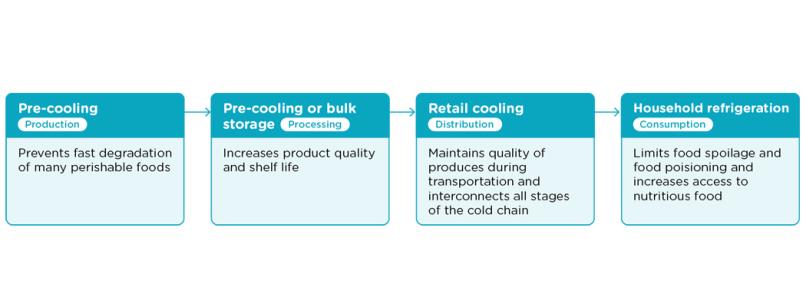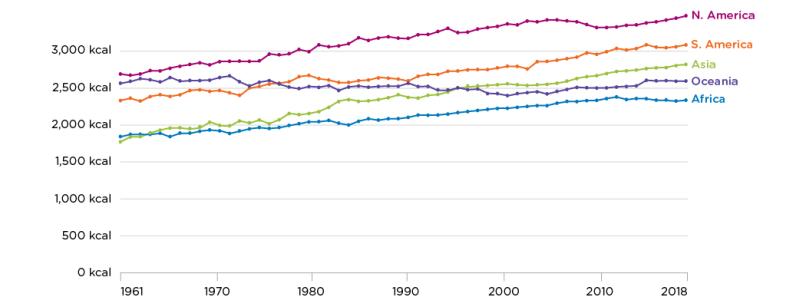Cooling for food, nutrition and agriculture
Key messages
- A lack of access to sustainable cooling and cold chain threatens to put SDG2 out of reach and stunt the ability of agricultural economies to grow sustainably.
- With access to sustainable cooling and cold chains, farmers can grow perishable, nutritious crops with confidence they will be able to transport them to markets that can deliver good prices.
- They can also use more income to create more jobs, including for women who are over half of the agricultural workforce in key developing markets.
13%
of all food production is lost due to lack of cold chain.
526 m
tonnes of food lost due to a lack of cold chains annually.
950 m
people could be fed with food currently lost to broken cold chains.
Overview
The cost of food loss and waste is estimated at nearly USD 1 trillion annually. Food is lost and wasted throughout various stages of the food supply chain, with 14 percent of all food produced lost between harvest and retail, and 17 percent of all food produced wasted in households, restaurants and across other food services. [1] [2] If food loss and waste were a country, it would be the third biggest emitter of carbon on the planet, at more than 3 billion tonnes of greenhouse gases (GHGs). [3] A 2018 study estimates that this figure will grow, with food loss and waste amounting to 2.1 billion tons of food annually, a global economic loss of USD 1.5 trillion in 2030 in a business-as-usual scenario. [4]
Access to sustainable cooling is a key enabler for solving these challenges and achieving SDG2 for the over 800 million people who suffer from hunger. It is estimated that a lack of sustainable cold chains, including freezers and refrigeration, directly results in 526 million tons of food production loss every year, [5] a factor that also contributes to the 15 percent reduction in smallholder farmers’ income. [6] Access to sustainable cooling is also closely linked to SDG7 since access to affordable and clean energy underpins the ability to access refrigeration and to move to more efficient and scalable food production.
In rural areas without access to affordable, reliable, and sustainable energy, expanding cooling infrastructure for agricultural purposes is a significant challenge. By expanding access, however, sustainable cooling solutions for food and agriculture can enable emissions reductions and the productive use of energy, for example through shifts in production to perishable crops that can be sold at higher prices in more distant markets.
For many food products, access to refrigeration is crucial to limiting food loss and to keeping produce as close to its post-harvest state as possible. Agricultural cold chains consist of several components, typically at least pre-cooling, cold storage and refrigerated transport (Figure 2.1).
Figure 2.1: The connection between the food supply chain and cold chain

Global food loss and waste trends
There are two primary issues in sustainable food systems: food loss and food waste. Food waste occurs at the retail or consumer level, where it is wasted due to behaviour, including storage, purchasing and consumption patterns, predominantly in high-income countries. It can also occur due to a lack of access to affordable refrigeration, causing spoilage, a loss of nutritional value and food safety issues.
However, the link between a lack of access to refrigeration and food wastage is largely intuitive and lacks reliable data for analysis; as a result, the analysis in this section focuses on food loss and the data available to understand its links to a lack of access to cooling. Food loss can be understood as damage and spoiling that occurs in the supply chain, with one of the primary drivers being a lack of appropriate temperature and humidity management during post-harvest: packaging, storage and transportation. In low-income countries, food loss in the supply chain is a major challenge, occurring mainly due to a lack of harvesting and processing capacity, as well as poorly functioning or non-existent cold chains. [7] Most countries with electricity access gaps have challenges establishing reliable cold chain infrastructure. [8] It has been observed that access to reliable and affordable electricity can improve agricultural yield [9] but the lack of cold chain results in significant post-harvest losses and loss of significant economic value.
Global trends show an average 3 percent annual increase in food loss from 2010 to 2019 (Figure 2.2) [10] with global total food loss (including non-perishables) in 2019 at a staggering 1.2 billion tonnes of food, equivalent to more than three times the food production of Africa annually.
Figure 2.2: Global food loss trends (2010–2019)
Global food loss is concentrated mainly in Asia, South America and Africa (Figure 2.2). At 48 percent, Asia has the highest food loss share. Each region’s share has remained largely the same except for North America, where it has tripled since 2013.
Food loss in low-income food deficit countries accounts for about 22 percent of the world’s total food loss and has consistently increased over the past decade, widening the food supply gap for large sections of vulnerable populations (Figure 2.3).
Figure 2.3: Food loss trends among the most vulnerable countries (2010–2019)
Source: SEforALL analysis of FAO data
Figure 2.4: Food supply trends (Kcal per person per day)

Food loss and trends in high-impact countries
Access to reliable cold chain at farms and improved refrigerator affordability can support a reduction of food loss, improved food security and higher incomes for people working in agriculture and food service jobs. However, having access to reliable and sustainable electricity and higher income levels for the poor, particularly women, is crucial for meeting nutritional standards, even with an increased supply of food.
The 54 high-impact countries for access to cooling [11] include 31 countries in Africa, 16 in Asia and the Middle East, six in Latin America and the Caribbean, and one in the Oceania region. An analysis of the volume of perishable food losses among these high-impact countries shows that more than 50 percent of the losses occur in China, followed by India (17 percent), Pakistan (7 percent) and Brazil (6 percent).
Out of the 31 high-impact African countries, only two (Egypt and Nigeria) have food loss shares of more than 2 percent each (Figure 2.5). The food loss percentage discrepancy in Africa in comparison to Asia and the Middle East is due to food loss being distributed across a greater number of countries, and the fact that the population of the countries in Asia and the Middle East, especially China and India, is far more than that of all the African countries combined.
Figure 2.5: Share of food losses in high-impact countries for access to cooling
Source: SEforALL analysis of FAO data
The impact of food loss on vulnerable populations is more evident when assessing the per-person food losses in high-impact countries. The average food loss is 35 kg per person per year and losses range between 3.8 kg to 62 kg per person in the 54 high-impact countries. Data show that Cameroon, China, the Dominican Republic, Pakistan and Peru are on the high end of that scale (Figure 2.6).
Figure 2.6: Food losses per person in high-impact countries for access to cooling
Source: SEforALL analysis of FAO data
In China and India, where food losses are highest by volume, per-capita losses are 57.3 kg and 21.6 kg respectively, while the Dominican Republic and Peru record the highest per-capita food losses, both with over 60 kg per capita. Among the 10 high-impact countries with highest food losses per person, four are in Africa – Angola, Cameroon, Mali and Papua New Guinea (Figure 2.7).
Figure 2.7: Top 10 per-person food losses in the 54 high-impact countries for access to cooling
Source: SEforALL analysis of FAO data
Reducing the loss of perishable food through adequate cold chain infrastructure and efficient supply chains can reduce the vulnerabilities of least developed countries (LDCs) [12] caused by food supply. For instance, LDCs have an annual average food supply of 505 kg per person, [13] and reducing the loss of perishable food in these countries can improve the necessary dietary nutrient supply available for their vulnerable populations.
Energy use and climate impact due to food production and loss
The production and supply of food is a process that uses a significant amount of energy and is a notable source of GHG emissions. Closing cooling access gaps in the agricultural sector through cooling efficiency improvements, an expansion of sustainable energy technology, and Kigali-compliant refrigerants, could avoid 55 percent of food losses experienced now and reduce cold chain emissions by 55 percent. [14]
On farms, for example, the use of electricity is necessary for pumps, packing houses and cold storage, and in the seafood sector marine vessels typically need cold storage on board – which at present relies primarily on fossil fuels. In these settings, investments in sustainable cold chain solutions help farmers reduce or improve the efficiency of their energy use while reducing food losses. At scale, these types of investments in productive uses of energy in agriculture and fisheries can reduce food loss and support reductions in energy waste that can be leveraged to expand access to unserved populations and improve the resilience of food systems.
Current energy use for food production in the 54 high-impact countries for access to cooling is dominated by major emerging economies. China’s energy use for food production alone is equivalent to that of Argentina, Brazil, India and Iran combined (Figure 2.8).
Figure 2.8: Food production energy use by country (2019)
Regionally, the amount of energy used in high-impact countries for access to cooling for food production, outside of manual labour, is highest in Asia, followed by South America and Africa. In Asia, 16 countries account for 78 percent of the energy use for food production, while in Africa 31 countries account for only 7 percent of energy use. It is notable that only five countries from South America account for 15 percent of energy use for food production. This trend has remained stable over the past decade (Figure 2.9).
Figure 2.9: Food production energy use by region for high-impact countries
Source: SEforALL analysis of FAO data
The energy efficiency of food production, however, shows that even though Africa has smaller food production and energy use compared to Asia and South America, some countries in Africa are highly energy inefficient for food production. The high-impact countries have a food production energy consumption range of 0.1 to 27.4 kg of food produced per kilowatt hour (equivalent) [15] of energy used, and of the top 10 most energy-inefficient countries, eight are in Africa (Figure 2.10).
Figure 2.10: Food production per unit of energy consumption (kg/kWh)
Source: SEforALL analysis of FAO data
Solutions for food, nutrition and agriculture
The lack of sustainable, resilient, accessible and affordable cooling is a major contributing factor for food loss, impeding the development of rural economies. Solutions to these challenges are multi-faceted, but an important first step are policy and guiding frameworks that target the development of agricultural cold chains, particularly in countries in Africa and Asia with the lowest food supply. These could include specific agricultural cold chain targets and strategies within a National Cooling Action Plan (NCAP) or a long-term agricultural sectoral development plan, as well as efforts to increase the productive use of energy through an integrated energy plan.
Enabling policies for sustainable cold chains also represents a major investment opportunity of USD 270 billion in supply chain infrastructure and supply chain efficiency, [16] but must be complemented by business model strategies that allow small-scale producers to access sustainable technology. Cooling as a Service (CaaS) is a servitization model that can support this, and Community Cooling Hubs can also reduce costs by aggregating local agricultural demand for cooling.
Technological innovations in off-grid refrigeration — cooling and freezing for agricultural cold chains — have demonstrated the potential impact of new technologies but have also shown that further market development is necessary for scale. Walk-in cold rooms, for example, can reduce post-harvest losses and improve local food security, but costs are currently prohibitively high, and new business models and effective supply chains are necessary for better integration
Notes and references
[1] FAO (2021). Transform food systems to avert $400 billion annually in loss and waste. Link.
[2] FAO (2014). Food Wastage Footprint: Full-cost Accounting. Final Report. Rome. Link.
[3] FAO (2021). Transform food systems to avert $400 billion annually in loss and waste. Link.
[4] Boston Consulting Group (2018). Tackling the 1.6-Billion-Ton Food Loss and Waste Crisis. Link.
[5] Sarr, J et al. “The Carbon Footprint of the Cold Chain, 7th Informatory Note on Refrigeration and Food.” IIR, 2021, Link.
[6] Peters, T, Leyla Sayin, et al. (2021). Status of the Global Food Cold Chain: Summary Briefing. Cool Coalition. Link.
[7] Norne Widell K. et al. (2019). Refrigeration to prevent food losses. Link.
[8] FAO (2021), Transforming food value chains: sustainable cooling solutions for agricultural cold chains. Link.
[9] Shirley R. et al. (2021). Identifying high-priority impact areas for electricity service to farmlands in Uganda through geospatial mapping. Journal of Agriculture and Food Research, Volume 5. Link.
[10] FAO perishable food loss data for dairy, meat and horticulture (vegetables and fruits). No data available on seafood loss.
[11] The Cooling for All high-impact countries for access to cooling, identified each year in Chilling Prospects, are those countries that have a combination of economic, climate and population conditions that place a significant portion of the population at risk due to a lack of access to cooling.
[12] Least developed countries (LDCs) are low-income countries that face severe structural impediments to sustainable development. They are highly vulnerable to economic and environmental shocks and have low levels of human assets. There are currently 46 countries on the list of LDCs that is reviewed every three years by the Committee for Development Policy (CDP), a subsidiary body of the UN Economic and Social Council (ECOSOC).
[13] FAO Statistic.
[14] Sarr, J et al. “The Carbon Footprint of the Cold Chain, 7th Informatory Note on Refrigeration and Food.” IIR, 2021, Link.
[15] Energy use in terajoules (TJ) converted to kWh of electricity for ease of reference.
[16] BCG (2018). Tackling the 1.6-Billion-Ton Food Loss and Waste Crisis. Link.


